CRKC7002: Analysis of McDonald's Marketing Strategies
VerifiedAdded on 2022/10/09
|7
|1478
|17
Report
AI Summary
This report provides a comprehensive analysis of McDonald's marketing strategies, focusing on key concepts such as the marketing mix, differentiation, and competitive advantage. It begins with an introduction to the critical role of marketing in achieving competitive advantages and organizational growth. The report then delves into McDonald's marketing mix, examining its products (including hamburgers, sandwiches, and beverages), pricing strategies (bundle pricing, psychological pricing), distribution channels (restaurants, kiosks, and apps), and promotional activities (advertisements, public relations, and promotional discounts). Furthermore, the report explores McDonald's differentiation strategy, highlighting how the company distinguishes itself through product quality, variety, and regional menu adaptations, as well as its competitive advantages, such as a large number of restaurants, technology, and employee training. The analysis also addresses the issue of commoditization in the fast-food industry and McDonald's approach to market segmentation based on geographic, demographic, behavioral, and psychographic variables. The report concludes that McDonald's is a global fast-food leader, with a marketing mix designed to target a broad consumer base and a strong focus on product quality and customer satisfaction, offering valuable insights into the company's strategies for maintaining its market position. The report uses several references to support its analysis.
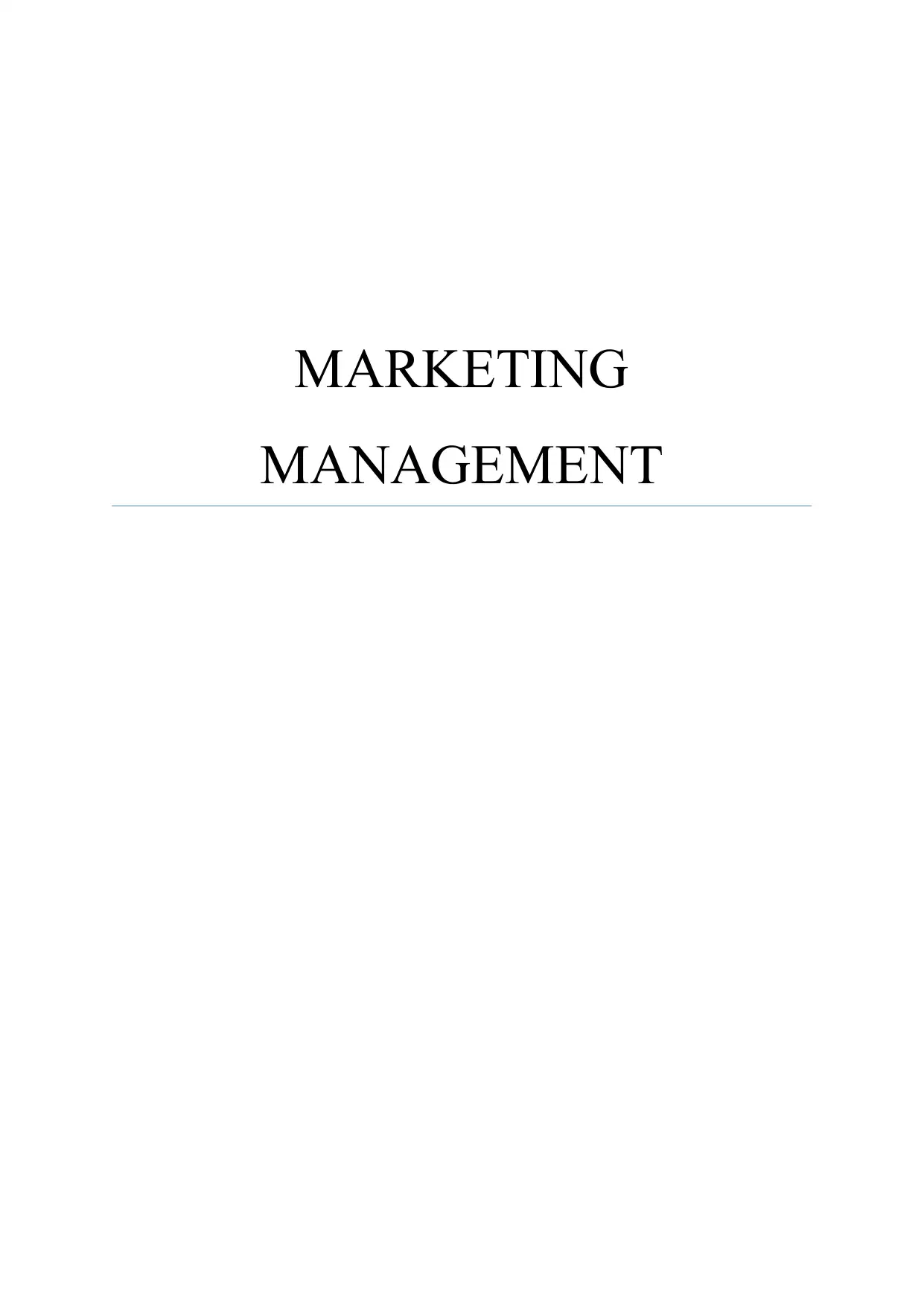
MARKETING
MANAGEMENT
MANAGEMENT
Paraphrase This Document
Need a fresh take? Get an instant paraphrase of this document with our AI Paraphraser
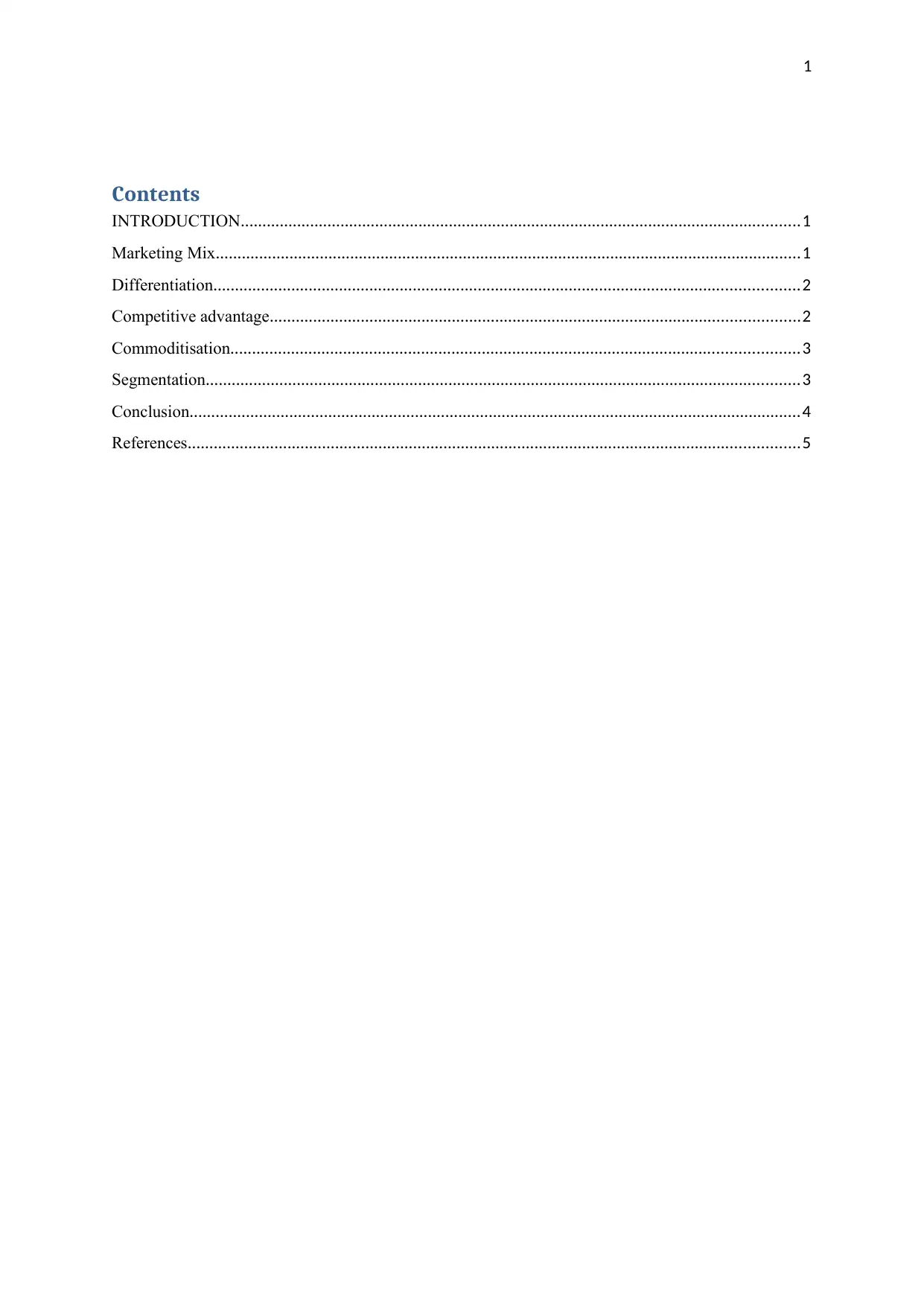
1
Contents
INTRODUCTION.................................................................................................................................1
Marketing Mix.......................................................................................................................................1
Differentiation.......................................................................................................................................2
Competitive advantage..........................................................................................................................2
Commoditisation...................................................................................................................................3
Segmentation.........................................................................................................................................3
Conclusion.............................................................................................................................................4
References.............................................................................................................................................5
Contents
INTRODUCTION.................................................................................................................................1
Marketing Mix.......................................................................................................................................1
Differentiation.......................................................................................................................................2
Competitive advantage..........................................................................................................................2
Commoditisation...................................................................................................................................3
Segmentation.........................................................................................................................................3
Conclusion.............................................................................................................................................4
References.............................................................................................................................................5
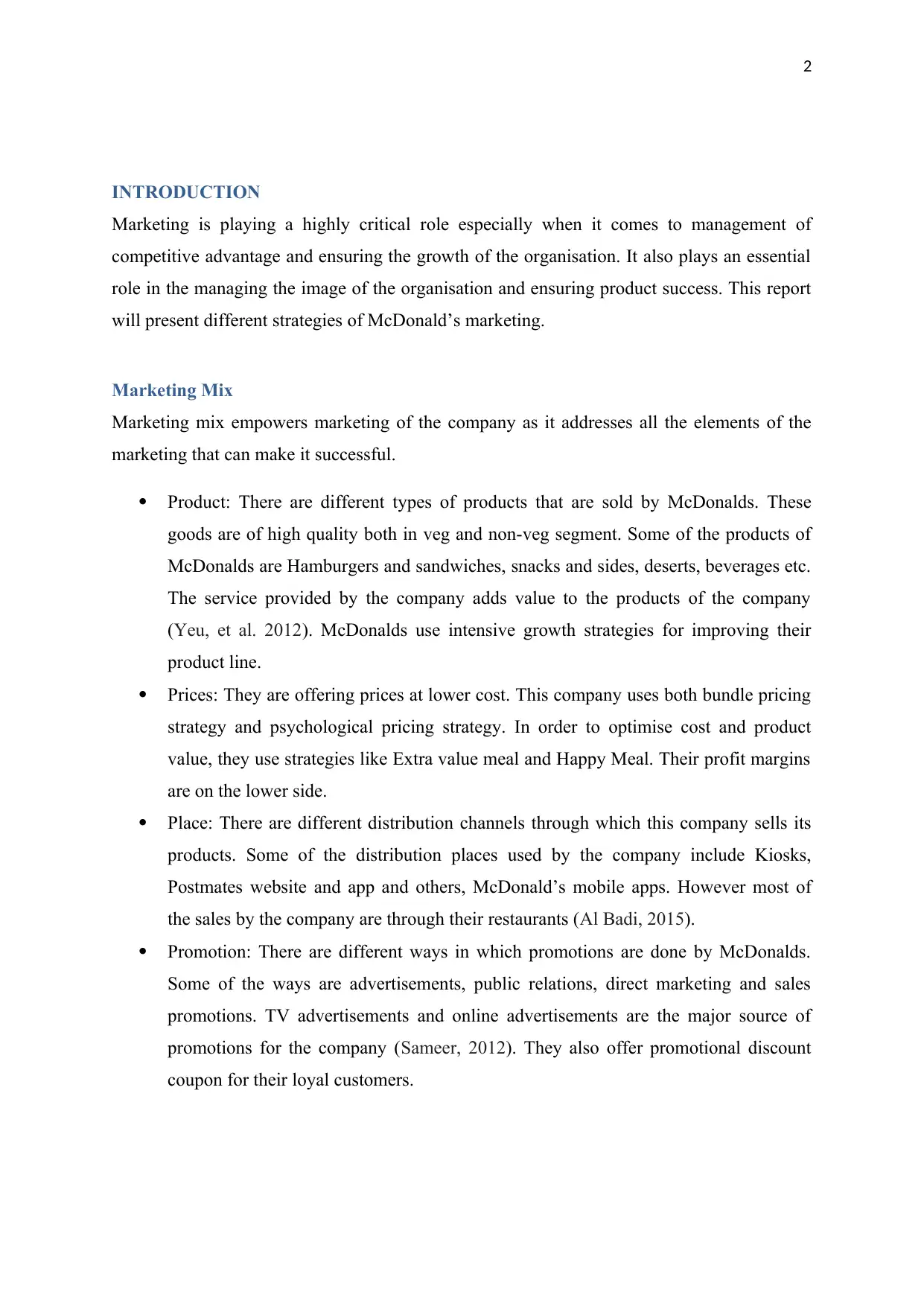
2
INTRODUCTION
Marketing is playing a highly critical role especially when it comes to management of
competitive advantage and ensuring the growth of the organisation. It also plays an essential
role in the managing the image of the organisation and ensuring product success. This report
will present different strategies of McDonald’s marketing.
Marketing Mix
Marketing mix empowers marketing of the company as it addresses all the elements of the
marketing that can make it successful.
Product: There are different types of products that are sold by McDonalds. These
goods are of high quality both in veg and non-veg segment. Some of the products of
McDonalds are Hamburgers and sandwiches, snacks and sides, deserts, beverages etc.
The service provided by the company adds value to the products of the company
(Yeu, et al. 2012). McDonalds use intensive growth strategies for improving their
product line.
Prices: They are offering prices at lower cost. This company uses both bundle pricing
strategy and psychological pricing strategy. In order to optimise cost and product
value, they use strategies like Extra value meal and Happy Meal. Their profit margins
are on the lower side.
Place: There are different distribution channels through which this company sells its
products. Some of the distribution places used by the company include Kiosks,
Postmates website and app and others, McDonald’s mobile apps. However most of
the sales by the company are through their restaurants (Al Badi, 2015).
Promotion: There are different ways in which promotions are done by McDonalds.
Some of the ways are advertisements, public relations, direct marketing and sales
promotions. TV advertisements and online advertisements are the major source of
promotions for the company (Sameer, 2012). They also offer promotional discount
coupon for their loyal customers.
INTRODUCTION
Marketing is playing a highly critical role especially when it comes to management of
competitive advantage and ensuring the growth of the organisation. It also plays an essential
role in the managing the image of the organisation and ensuring product success. This report
will present different strategies of McDonald’s marketing.
Marketing Mix
Marketing mix empowers marketing of the company as it addresses all the elements of the
marketing that can make it successful.
Product: There are different types of products that are sold by McDonalds. These
goods are of high quality both in veg and non-veg segment. Some of the products of
McDonalds are Hamburgers and sandwiches, snacks and sides, deserts, beverages etc.
The service provided by the company adds value to the products of the company
(Yeu, et al. 2012). McDonalds use intensive growth strategies for improving their
product line.
Prices: They are offering prices at lower cost. This company uses both bundle pricing
strategy and psychological pricing strategy. In order to optimise cost and product
value, they use strategies like Extra value meal and Happy Meal. Their profit margins
are on the lower side.
Place: There are different distribution channels through which this company sells its
products. Some of the distribution places used by the company include Kiosks,
Postmates website and app and others, McDonald’s mobile apps. However most of
the sales by the company are through their restaurants (Al Badi, 2015).
Promotion: There are different ways in which promotions are done by McDonalds.
Some of the ways are advertisements, public relations, direct marketing and sales
promotions. TV advertisements and online advertisements are the major source of
promotions for the company (Sameer, 2012). They also offer promotional discount
coupon for their loyal customers.
⊘ This is a preview!⊘
Do you want full access?
Subscribe today to unlock all pages.

Trusted by 1+ million students worldwide
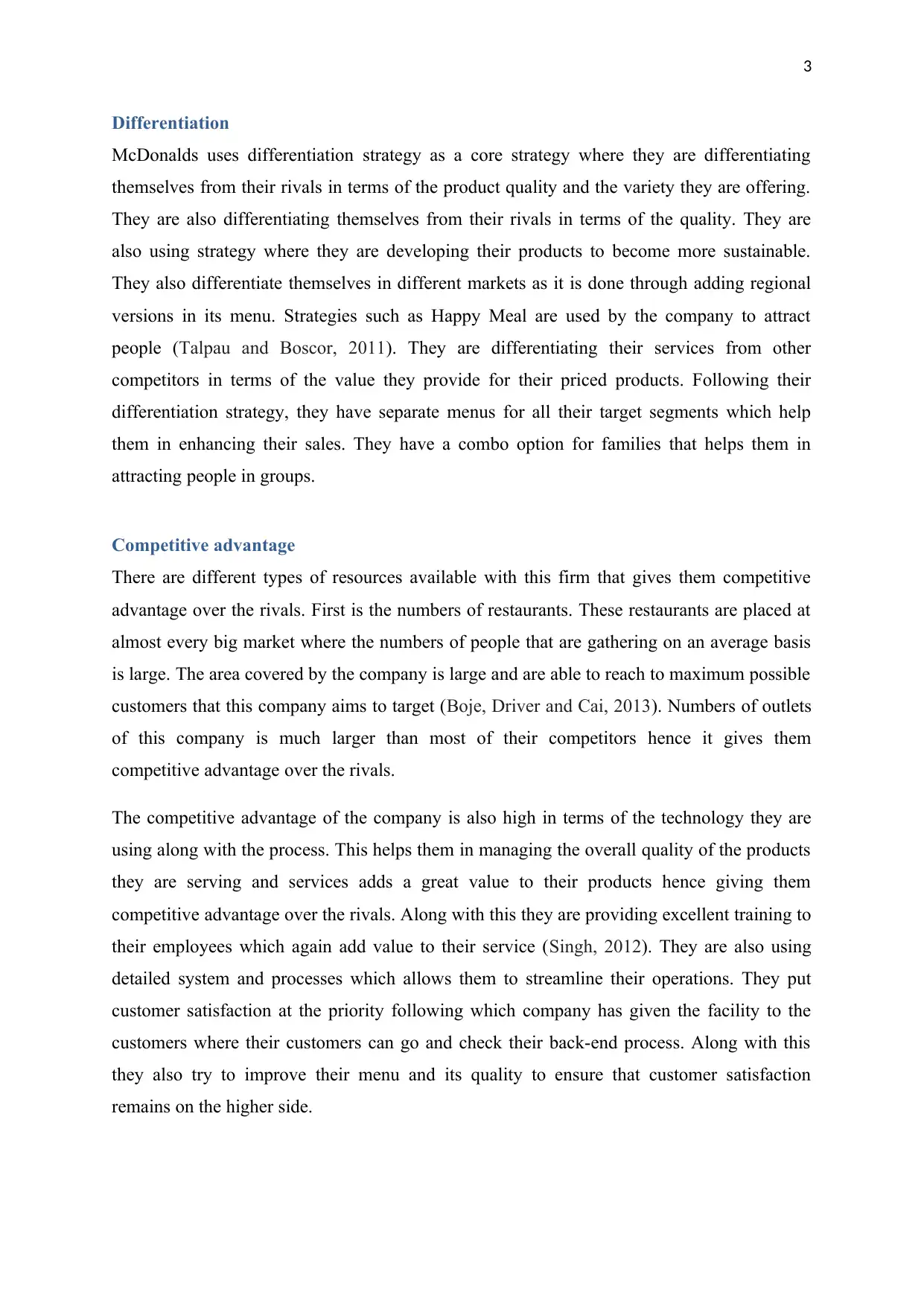
3
Differentiation
McDonalds uses differentiation strategy as a core strategy where they are differentiating
themselves from their rivals in terms of the product quality and the variety they are offering.
They are also differentiating themselves from their rivals in terms of the quality. They are
also using strategy where they are developing their products to become more sustainable.
They also differentiate themselves in different markets as it is done through adding regional
versions in its menu. Strategies such as Happy Meal are used by the company to attract
people (Talpau and Boscor, 2011). They are differentiating their services from other
competitors in terms of the value they provide for their priced products. Following their
differentiation strategy, they have separate menus for all their target segments which help
them in enhancing their sales. They have a combo option for families that helps them in
attracting people in groups.
Competitive advantage
There are different types of resources available with this firm that gives them competitive
advantage over the rivals. First is the numbers of restaurants. These restaurants are placed at
almost every big market where the numbers of people that are gathering on an average basis
is large. The area covered by the company is large and are able to reach to maximum possible
customers that this company aims to target (Boje, Driver and Cai, 2013). Numbers of outlets
of this company is much larger than most of their competitors hence it gives them
competitive advantage over the rivals.
The competitive advantage of the company is also high in terms of the technology they are
using along with the process. This helps them in managing the overall quality of the products
they are serving and services adds a great value to their products hence giving them
competitive advantage over the rivals. Along with this they are providing excellent training to
their employees which again add value to their service (Singh, 2012). They are also using
detailed system and processes which allows them to streamline their operations. They put
customer satisfaction at the priority following which company has given the facility to the
customers where their customers can go and check their back-end process. Along with this
they also try to improve their menu and its quality to ensure that customer satisfaction
remains on the higher side.
Differentiation
McDonalds uses differentiation strategy as a core strategy where they are differentiating
themselves from their rivals in terms of the product quality and the variety they are offering.
They are also differentiating themselves from their rivals in terms of the quality. They are
also using strategy where they are developing their products to become more sustainable.
They also differentiate themselves in different markets as it is done through adding regional
versions in its menu. Strategies such as Happy Meal are used by the company to attract
people (Talpau and Boscor, 2011). They are differentiating their services from other
competitors in terms of the value they provide for their priced products. Following their
differentiation strategy, they have separate menus for all their target segments which help
them in enhancing their sales. They have a combo option for families that helps them in
attracting people in groups.
Competitive advantage
There are different types of resources available with this firm that gives them competitive
advantage over the rivals. First is the numbers of restaurants. These restaurants are placed at
almost every big market where the numbers of people that are gathering on an average basis
is large. The area covered by the company is large and are able to reach to maximum possible
customers that this company aims to target (Boje, Driver and Cai, 2013). Numbers of outlets
of this company is much larger than most of their competitors hence it gives them
competitive advantage over the rivals.
The competitive advantage of the company is also high in terms of the technology they are
using along with the process. This helps them in managing the overall quality of the products
they are serving and services adds a great value to their products hence giving them
competitive advantage over the rivals. Along with this they are providing excellent training to
their employees which again add value to their service (Singh, 2012). They are also using
detailed system and processes which allows them to streamline their operations. They put
customer satisfaction at the priority following which company has given the facility to the
customers where their customers can go and check their back-end process. Along with this
they also try to improve their menu and its quality to ensure that customer satisfaction
remains on the higher side.
Paraphrase This Document
Need a fresh take? Get an instant paraphrase of this document with our AI Paraphraser
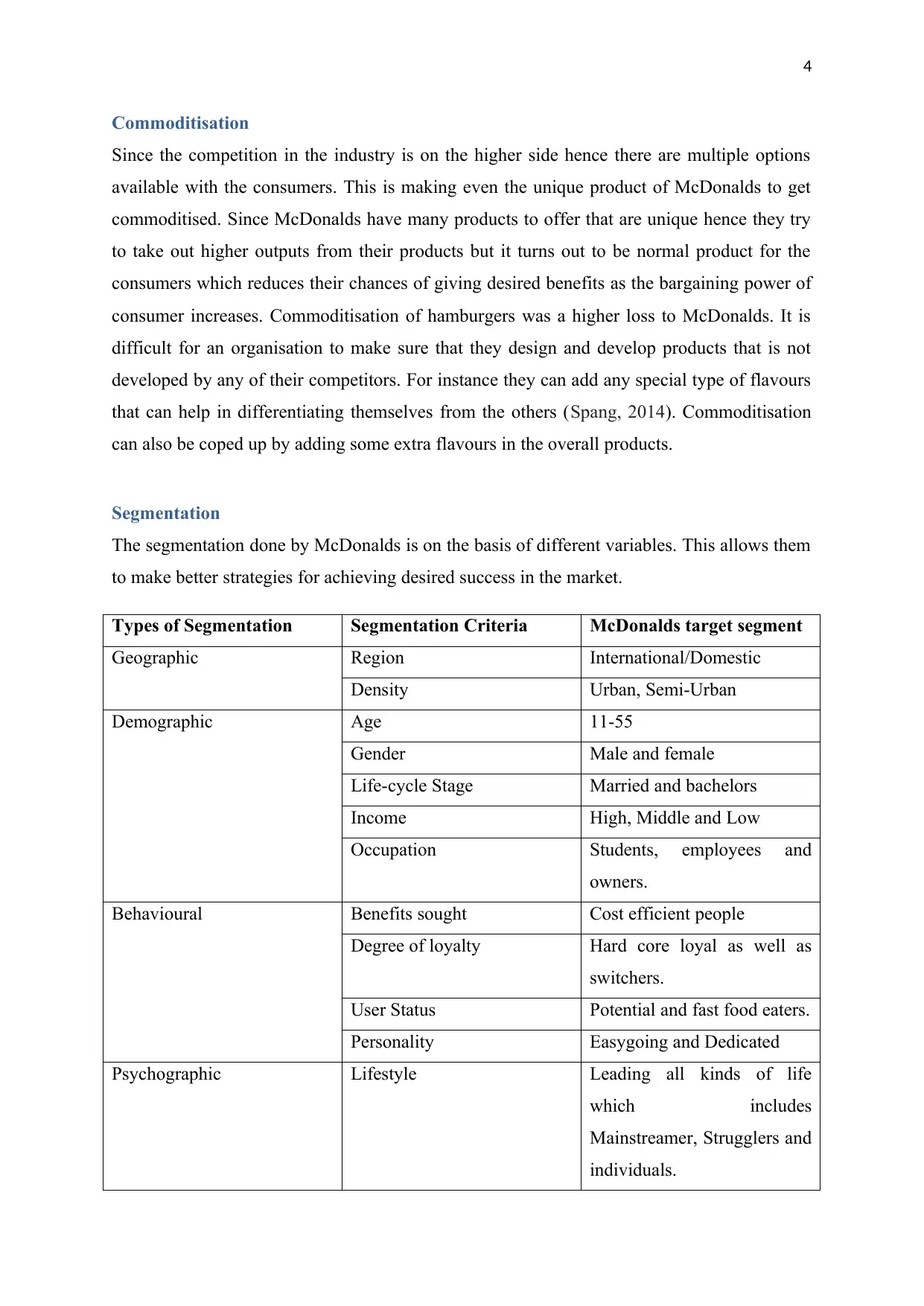
4
Commoditisation
Since the competition in the industry is on the higher side hence there are multiple options
available with the consumers. This is making even the unique product of McDonalds to get
commoditised. Since McDonalds have many products to offer that are unique hence they try
to take out higher outputs from their products but it turns out to be normal product for the
consumers which reduces their chances of giving desired benefits as the bargaining power of
consumer increases. Commoditisation of hamburgers was a higher loss to McDonalds. It is
difficult for an organisation to make sure that they design and develop products that is not
developed by any of their competitors. For instance they can add any special type of flavours
that can help in differentiating themselves from the others (Spang, 2014). Commoditisation
can also be coped up by adding some extra flavours in the overall products.
Segmentation
The segmentation done by McDonalds is on the basis of different variables. This allows them
to make better strategies for achieving desired success in the market.
Types of Segmentation Segmentation Criteria McDonalds target segment
Geographic Region International/Domestic
Density Urban, Semi-Urban
Demographic Age 11-55
Gender Male and female
Life-cycle Stage Married and bachelors
Income High, Middle and Low
Occupation Students, employees and
owners.
Behavioural Benefits sought Cost efficient people
Degree of loyalty Hard core loyal as well as
switchers.
User Status Potential and fast food eaters.
Personality Easygoing and Dedicated
Psychographic Lifestyle Leading all kinds of life
which includes
Mainstreamer, Strugglers and
individuals.
Commoditisation
Since the competition in the industry is on the higher side hence there are multiple options
available with the consumers. This is making even the unique product of McDonalds to get
commoditised. Since McDonalds have many products to offer that are unique hence they try
to take out higher outputs from their products but it turns out to be normal product for the
consumers which reduces their chances of giving desired benefits as the bargaining power of
consumer increases. Commoditisation of hamburgers was a higher loss to McDonalds. It is
difficult for an organisation to make sure that they design and develop products that is not
developed by any of their competitors. For instance they can add any special type of flavours
that can help in differentiating themselves from the others (Spang, 2014). Commoditisation
can also be coped up by adding some extra flavours in the overall products.
Segmentation
The segmentation done by McDonalds is on the basis of different variables. This allows them
to make better strategies for achieving desired success in the market.
Types of Segmentation Segmentation Criteria McDonalds target segment
Geographic Region International/Domestic
Density Urban, Semi-Urban
Demographic Age 11-55
Gender Male and female
Life-cycle Stage Married and bachelors
Income High, Middle and Low
Occupation Students, employees and
owners.
Behavioural Benefits sought Cost efficient people
Degree of loyalty Hard core loyal as well as
switchers.
User Status Potential and fast food eaters.
Personality Easygoing and Dedicated
Psychographic Lifestyle Leading all kinds of life
which includes
Mainstreamer, Strugglers and
individuals.
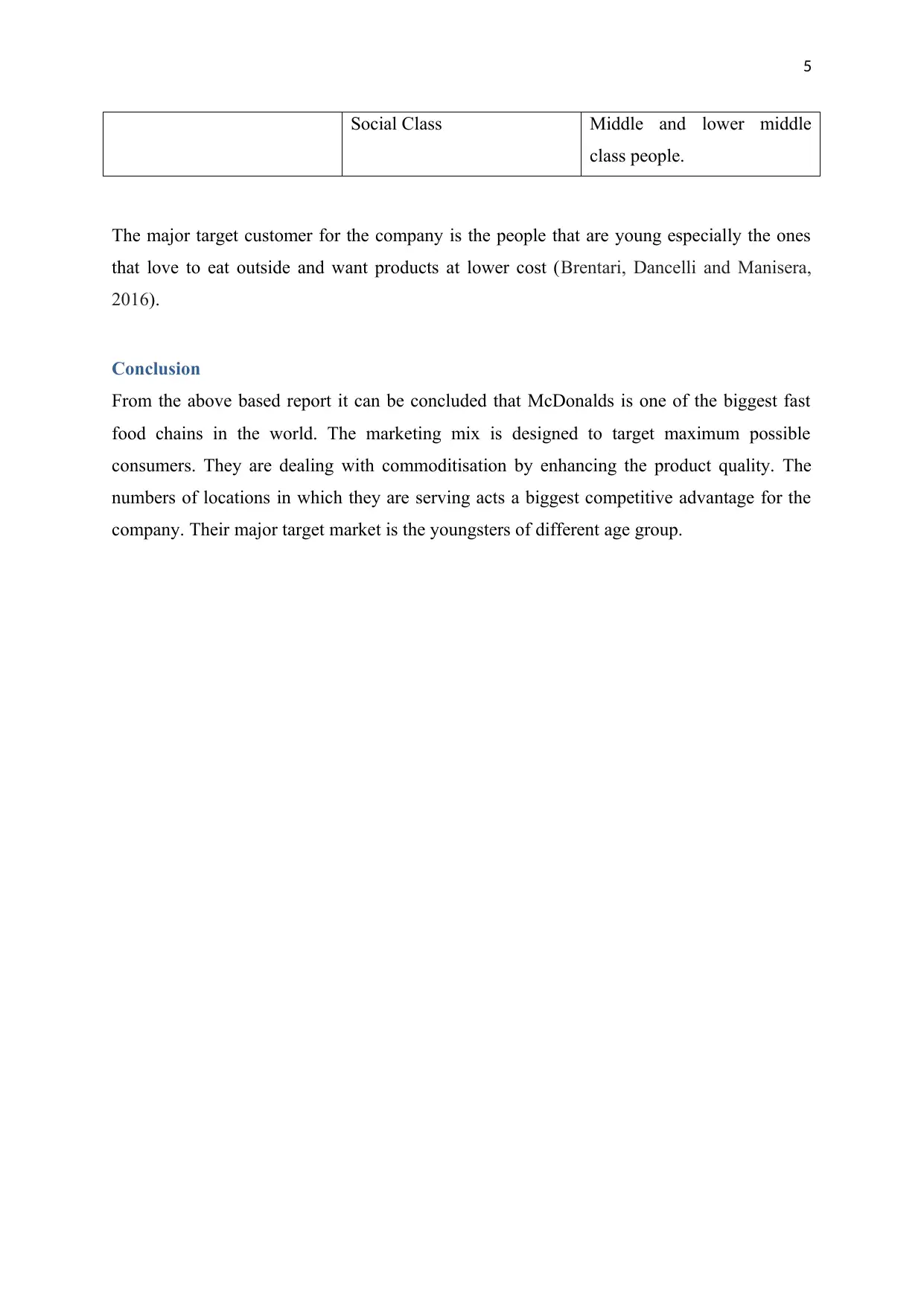
5
Social Class Middle and lower middle
class people.
The major target customer for the company is the people that are young especially the ones
that love to eat outside and want products at lower cost (Brentari, Dancelli and Manisera,
2016).
Conclusion
From the above based report it can be concluded that McDonalds is one of the biggest fast
food chains in the world. The marketing mix is designed to target maximum possible
consumers. They are dealing with commoditisation by enhancing the product quality. The
numbers of locations in which they are serving acts a biggest competitive advantage for the
company. Their major target market is the youngsters of different age group.
Social Class Middle and lower middle
class people.
The major target customer for the company is the people that are young especially the ones
that love to eat outside and want products at lower cost (Brentari, Dancelli and Manisera,
2016).
Conclusion
From the above based report it can be concluded that McDonalds is one of the biggest fast
food chains in the world. The marketing mix is designed to target maximum possible
consumers. They are dealing with commoditisation by enhancing the product quality. The
numbers of locations in which they are serving acts a biggest competitive advantage for the
company. Their major target market is the youngsters of different age group.
⊘ This is a preview!⊘
Do you want full access?
Subscribe today to unlock all pages.

Trusted by 1+ million students worldwide
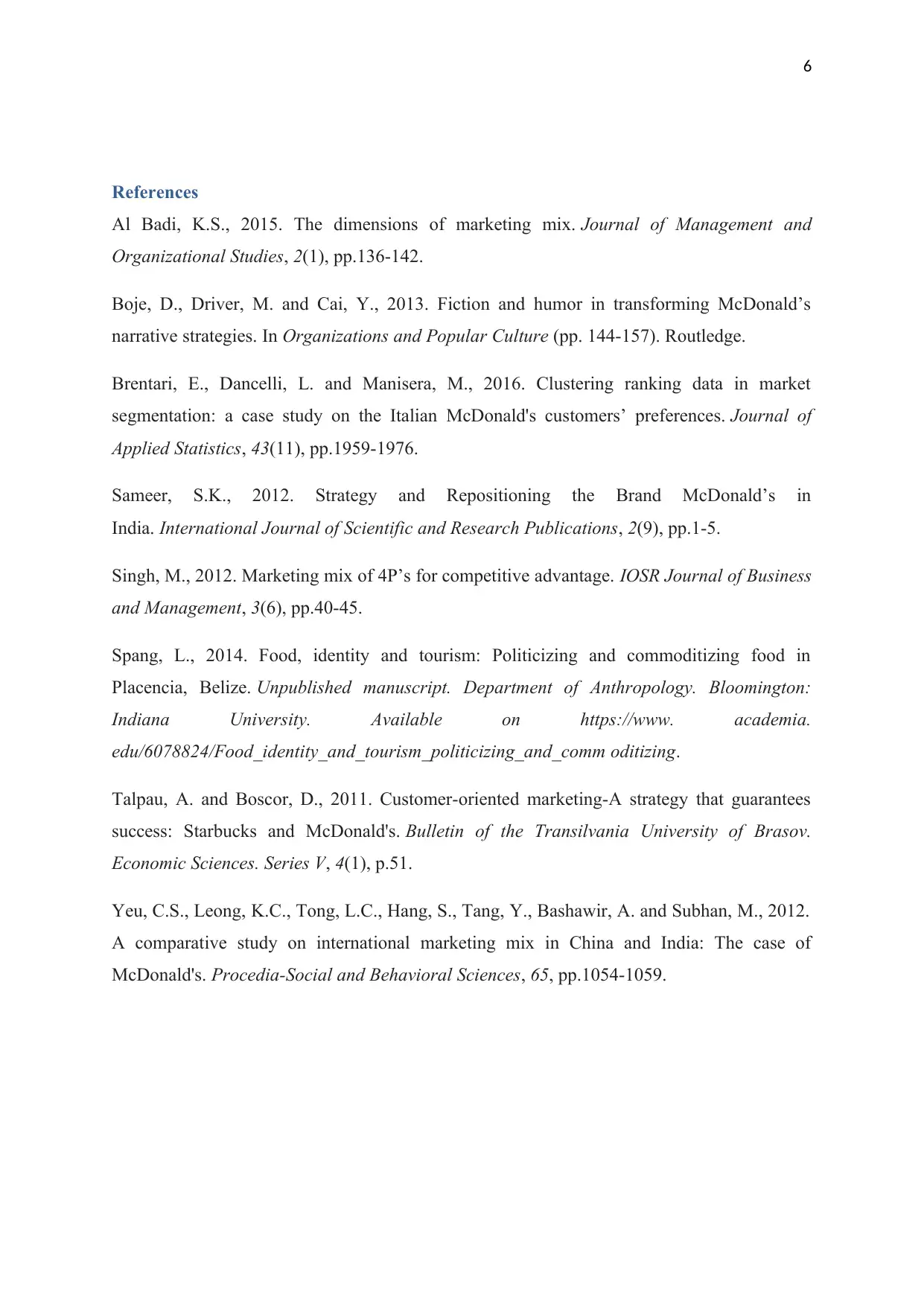
6
References
Al Badi, K.S., 2015. The dimensions of marketing mix. Journal of Management and
Organizational Studies, 2(1), pp.136-142.
Boje, D., Driver, M. and Cai, Y., 2013. Fiction and humor in transforming McDonald’s
narrative strategies. In Organizations and Popular Culture (pp. 144-157). Routledge.
Brentari, E., Dancelli, L. and Manisera, M., 2016. Clustering ranking data in market
segmentation: a case study on the Italian McDonald's customers’ preferences. Journal of
Applied Statistics, 43(11), pp.1959-1976.
Sameer, S.K., 2012. Strategy and Repositioning the Brand McDonald’s in
India. International Journal of Scientific and Research Publications, 2(9), pp.1-5.
Singh, M., 2012. Marketing mix of 4P’s for competitive advantage. IOSR Journal of Business
and Management, 3(6), pp.40-45.
Spang, L., 2014. Food, identity and tourism: Politicizing and commoditizing food in
Placencia, Belize. Unpublished manuscript. Department of Anthropology. Bloomington:
Indiana University. Available on https://www. academia.
edu/6078824/Food_identity_and_tourism_politicizing_and_comm oditizing.
Talpau, A. and Boscor, D., 2011. Customer-oriented marketing-A strategy that guarantees
success: Starbucks and McDonald's. Bulletin of the Transilvania University of Brasov.
Economic Sciences. Series V, 4(1), p.51.
Yeu, C.S., Leong, K.C., Tong, L.C., Hang, S., Tang, Y., Bashawir, A. and Subhan, M., 2012.
A comparative study on international marketing mix in China and India: The case of
McDonald's. Procedia-Social and Behavioral Sciences, 65, pp.1054-1059.
References
Al Badi, K.S., 2015. The dimensions of marketing mix. Journal of Management and
Organizational Studies, 2(1), pp.136-142.
Boje, D., Driver, M. and Cai, Y., 2013. Fiction and humor in transforming McDonald’s
narrative strategies. In Organizations and Popular Culture (pp. 144-157). Routledge.
Brentari, E., Dancelli, L. and Manisera, M., 2016. Clustering ranking data in market
segmentation: a case study on the Italian McDonald's customers’ preferences. Journal of
Applied Statistics, 43(11), pp.1959-1976.
Sameer, S.K., 2012. Strategy and Repositioning the Brand McDonald’s in
India. International Journal of Scientific and Research Publications, 2(9), pp.1-5.
Singh, M., 2012. Marketing mix of 4P’s for competitive advantage. IOSR Journal of Business
and Management, 3(6), pp.40-45.
Spang, L., 2014. Food, identity and tourism: Politicizing and commoditizing food in
Placencia, Belize. Unpublished manuscript. Department of Anthropology. Bloomington:
Indiana University. Available on https://www. academia.
edu/6078824/Food_identity_and_tourism_politicizing_and_comm oditizing.
Talpau, A. and Boscor, D., 2011. Customer-oriented marketing-A strategy that guarantees
success: Starbucks and McDonald's. Bulletin of the Transilvania University of Brasov.
Economic Sciences. Series V, 4(1), p.51.
Yeu, C.S., Leong, K.C., Tong, L.C., Hang, S., Tang, Y., Bashawir, A. and Subhan, M., 2012.
A comparative study on international marketing mix in China and India: The case of
McDonald's. Procedia-Social and Behavioral Sciences, 65, pp.1054-1059.
1 out of 7
Related Documents
Your All-in-One AI-Powered Toolkit for Academic Success.
+13062052269
info@desklib.com
Available 24*7 on WhatsApp / Email
![[object Object]](/_next/static/media/star-bottom.7253800d.svg)
Unlock your academic potential
Copyright © 2020–2025 A2Z Services. All Rights Reserved. Developed and managed by ZUCOL.





